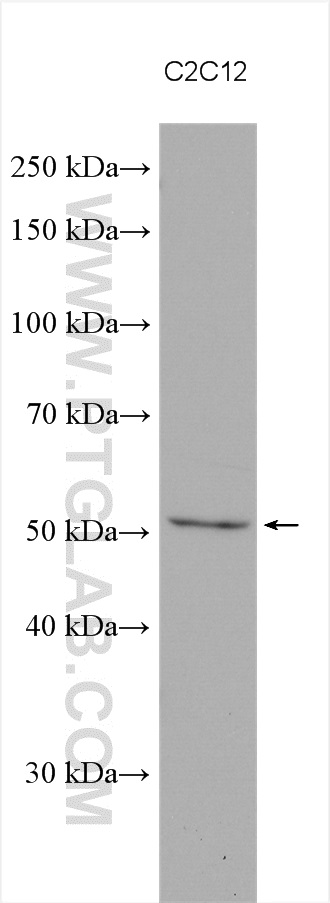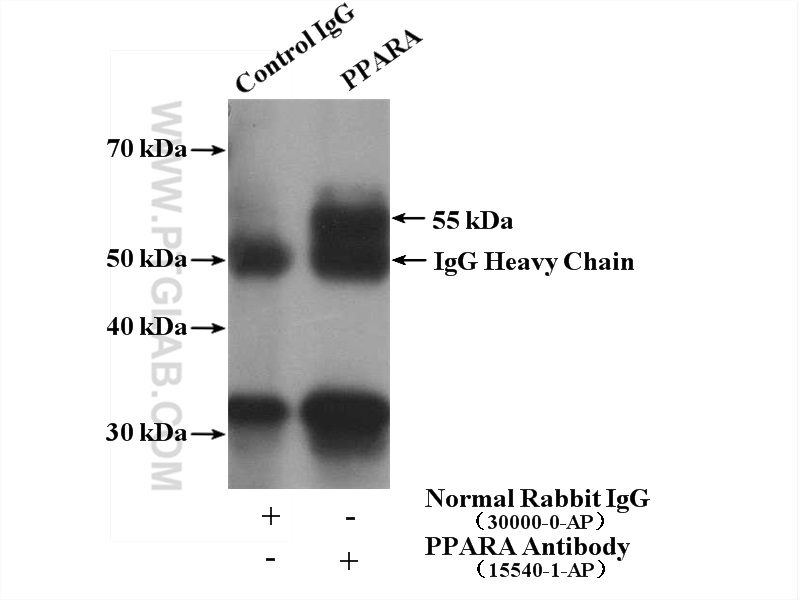验证数据展示
经过测试的应用
| Positive WB detected in | C2C12 cells |
| Positive IP detected in | U-937 cells |
推荐稀释比
| 应用 | 推荐稀释比 |
|---|---|
| Western Blot (WB) | WB : 1:500-1:1000 |
| Immunoprecipitation (IP) | IP : 0.5-4.0 ug for 1.0-3.0 mg of total protein lysate |
| It is recommended that this reagent should be titrated in each testing system to obtain optimal results. | |
| Sample-dependent, Check data in validation data gallery. | |
产品信息
15540-1-AP targets PPARA in WB, IF, IP, CoIP, ChIP, ELISA applications and shows reactivity with human, mouse, rat samples.
| 经测试应用 | WB, IP, ELISA Application Description |
| 文献引用应用 | WB, IF, CoIP, ChIP |
| 经测试反应性 | human, mouse, rat |
| 文献引用反应性 | human, mouse, rat, pig, chicken, bovine, hamster, goat |
| 免疫原 |
CatNo: Ag7896 Product name: Recombinant human PPARA protein Source: e coli.-derived, PGEX-4T Tag: GST Domain: 1-258 aa of BC000052 Sequence: MVDTESPLCPLSPLEAGDLESPLSEEFLQEMGNIQEISQSIGEDSSGSFGFTEYQYLGSCPGSDGSVITDTLSPASSPSSVTYPVVPGSVDESPSGALNIECRICGDKASGYHYGVHACEGCKGFFRRTIRLKLVYDKCDRSCKIQKKNRNKCQYCRFHKCLSVGMSHNAIRFGRMPRSEKAKLKAEILTCEHDIEDSETADLKSLAKRIYEAYLKNFNMNKVKARVILSGKASNNPVGVCGCSGFSWQHGTSVVEDD 种属同源性预测 |
| 宿主/亚型 | Rabbit / IgG |
| 抗体类别 | Polyclonal |
| 产品类型 | Antibody |
| 全称 | peroxisome proliferator-activated receptor alpha |
| 别名 | hPPAR, NR1C1, PPAR, PPAR alpha, PPARA, PPARα |
| 计算分子量 | 52 kDa |
| 观测分子量 | 52 kDa |
| GenBank蛋白编号 | BC000052 |
| 基因名称 | PPARA |
| Gene ID (NCBI) | 5465 |
| RRID | AB_2252506 |
| 偶联类型 | Unconjugated |
| 形式 | Liquid |
| 纯化方式 | Antigen affinity purification |
| UNIPROT ID | Q07869 |
| 储存缓冲液 | PBS with 0.02% sodium azide and 50% glycerol, pH 7.3. |
| 储存条件 | Store at -20°C. Stable for one year after shipment. Aliquoting is unnecessary for -20oC storage. |
背景介绍
Peroxisome proliferator-activated receptor alpha (PPARA) is a ligand-activated transcription factor that belongs to the PPAR nuclear receptor superfamily. PPARA is essential in the modulation of lipid transport and metabolism, mainly through activating mitochondrial and peroxisomal fatty acid β-oxidation pathways. In addition, PPARA seems to decrease inflammation mainly through direct interaction with NF-κB, causing inhibition of its signaling pathway or reducing the activated levels of NF-κB and subsequent inflammation. Furthermore, PPARA was implicated in the attenuation of oxidative stress in alcoholic liver disease when treated with polyenephosphatidylcholine through downregulation of ROS-generating enzymes such as ethanol-inducible cytochrome P450 2E1 (CYP2E1), acyl-CoA oxidase, and NADPH oxidase. PPARA exists two isoforms and molecular weight of PPARA isoforms are 52 kDa and 22 kDa. The ability of a retinoid X receptor (RXR) to heterodimerize with many nuclear receptors, including LXR, PPAR, NGF1B and RAR, underscores its pivotal role within the nuclear receptor superfamily. Among these heterodimers, PPAR:RXR is considered an important signalling mediator of both PPAR ligands, such as fatty acids, and 9-cis retinoic acid (9-cis RA), an RXR ligand. (PMID: 15103326 ). PPARA can form Heterodimer with RXRA and molecular weight of Heterodimer is about 110 kDa.
发表文章
| Species | Application | Title |
|---|---|---|
Nat Commun Hyodeoxycholic acid ameliorates nonalcoholic fatty liver disease by inhibiting RAN-mediated PPARα nucleus-cytoplasm shuttling | ||
Sci Adv Small-molecule inhibitor targeting orphan nuclear receptor COUP-TFII for prostate cancer treatment. | ||
Hepatology The histone methyltransferase Suv39h2 contributes to nonalcoholic steatohepatitis in mice. | ||
Nat Commun N1-methyladenosine methylation in tRNA drives liver tumourigenesis by regulating cholesterol metabolism. | ||



